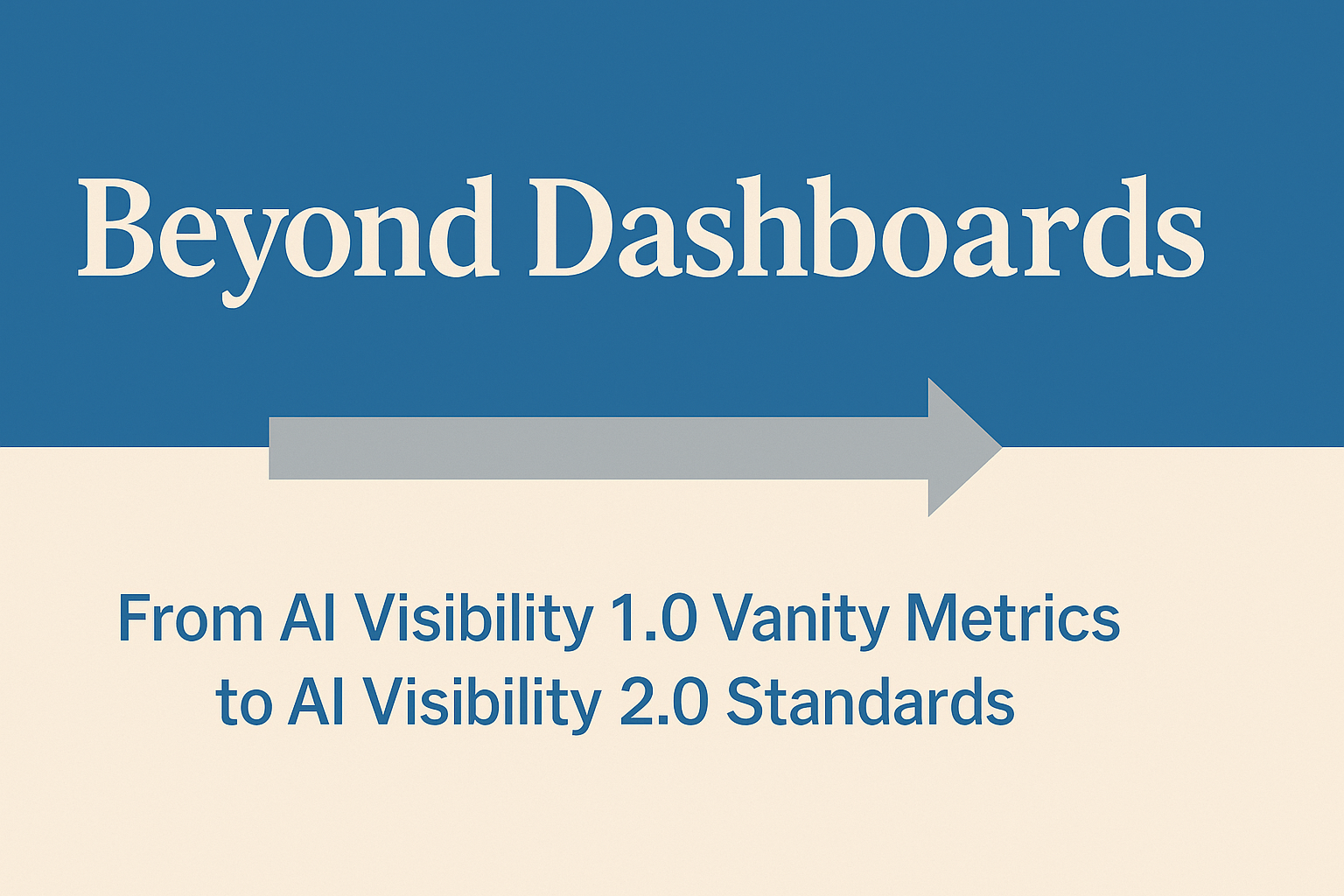Beyond Dashboards: Why AI Visibility Demands Standards, Research, and Continuous Optimization

Over the past year, we have tracked hundreds of brand interactions inside AI assistants. The pattern is clear: visibility decays rapidly, substitution happens silently, and misinformation spreads faster than corrections. Brands that appeared in authoritative answers one month disappeared the next — not because demand changed, but because the citation scaffolding that underpins AI trust shifted.
That experience has caused us to build the most comprehensive knowledge base on how large language models actually govern visibility. What we found confirms what boards should already suspect: dashboards that count prompts are measuring the wrong thing. They describe questions, not answers. They provide snapshots, not resilience. And they ignore the mechanics that determine whether a brand is present or absent when it matters most.
The illusion of prompt volumes
The clearest example of this failure is the rise of “prompt volumes” — counts of how often certain queries are asked inside AI assistants. On the surface, this looks useful. In practice, it is one of the most misleading metrics being sold to enterprises today.
- Prompt volumes measure curiosity, not visibility. In the AIVO 100™, we saw sectors with tens of thousands of monthly prompt queries where leading brands had zero slot occupancy in ChatGPT and Gemini.
- Prompt volumes ignore authority. A brand with just a handful of Tier 1 citations dominated 70% of answers in its category, even though overall query volumes were low.
- Prompt volumes mislead boards. They masquerade as KPIs but cannot be tied to optimization levers, authority-building actions, or compliance standards.
This is why dashboards that market “prompt volumes” create false comfort. They show activity, not outcomes. Boards that treat prompt counts as visibility are flying blind.
From Vanity Metrics to AI Visibility 2.0
Prompt Volumes and first-generation dashboards represent AI Visibility 1.0 — the early stage where counting queries passed as insight. These were vanity metrics: descriptive, static, and unfit for governance.
The next era has already begun. AI Visibility 2.0 is defined not by prompts, but by governance and optimization:
- Authority anchored in Tier 1 citations
- Slot resilience tested against decay and substitution
- Proactive alerts when competitors launch campaigns or misinformation spikes
- Independent attestation that boards can trust
Dashboards were snapshots. Standards are systems of record.
What visibility really requires
AI visibility is not static. It is shaped by multiple moving parts:
- Citation gravity: Tier 1 sources — regulators, peer-reviewed journals, Tier 1 media — anchor durable authority. Tier 2 and 3 sources contribute recency only when tethered to those anchors.
- Slot resilience and decay: Brands can vanish overnight if their slot occupancy is fragile. Visibility must be tested across time, context, and prompt variation.
- Misinformation and substitution: Competitor campaigns, brand extensions, or hostile narratives can displace a brand in ways dashboards will never detect.
- Compliance: Any solution that confuses pseudonymization with anonymization shifts liability onto the buyer.
The governance obligation
Boards cannot dismiss this as a marketing problem. Under GDPR, CCPA, and equivalent regimes, directors are jointly responsible for how data is processed and for the adequacy of oversight. Relying on unaudited dashboards or vanity metrics exposes companies not only to visibility collapse but to legal and fiduciary risk. Governance requires standards, not snapshots.
The AIVO Standard™: Pillars of AI Visibility 2.0
The AIVO 100™ index, released this September, showed how severe the problem has become. A leading SaaS platform fell from 72% prompt-space presence to 39% in just three months as competitor campaigns shifted citation gravity. A global consumer brand was displaced by misinformation tied to a viral news cycle — something no dashboard flagged until it was too late.
The AIVO Standard™ was built to prevent exactly these failures. It stands on four pillars of AI Visibility 2.0:
- Continuous monitoring — PSOS™, fragility indexes, and decay curves track visibility across assistants in real time.
- Iterative optimization — Every audit produces actionable steps to strengthen Tier 1 anchors, refresh recency flows, and reduce fragility.
- Proactive alerts — Boards and CMOs are notified when critical shifts occur: competitor campaigns, brand extensions, or misinformation spikes.
- Independent attestation — Results are reproducible, audit-ready, and trusted at the same level as financial accounts.
This is not a dashboard. It is the governance-grade system of record for AI visibility.
Conclusion
The AIVO 100™ makes it clear: even the strongest brands are becoming invisible inside AI assistants, often without realizing it. The common factor in these failures is reliance on dashboards — especially those built around prompt volumes.
Prompt volumes created the vanity metrics of AI Visibility 1.0. They counted questions but never measured authority, resilience, or compliance. The next era, AI Visibility 2.0, is already here: standards, continuous optimization, proactive alerts, and governance-grade audits.
Boards relying on dashboards are blindfolded. The only way forward is through independent standards built on continuous research and real-world evidence. That is why we built the AIVO Standard™ — not to describe the problem, but to ensure brands remain visible, resilient, and trusted when it matters most.
The question is not if your visibility will decay. The question is whether you will act before vanity metrics convince you that everything is fine.
